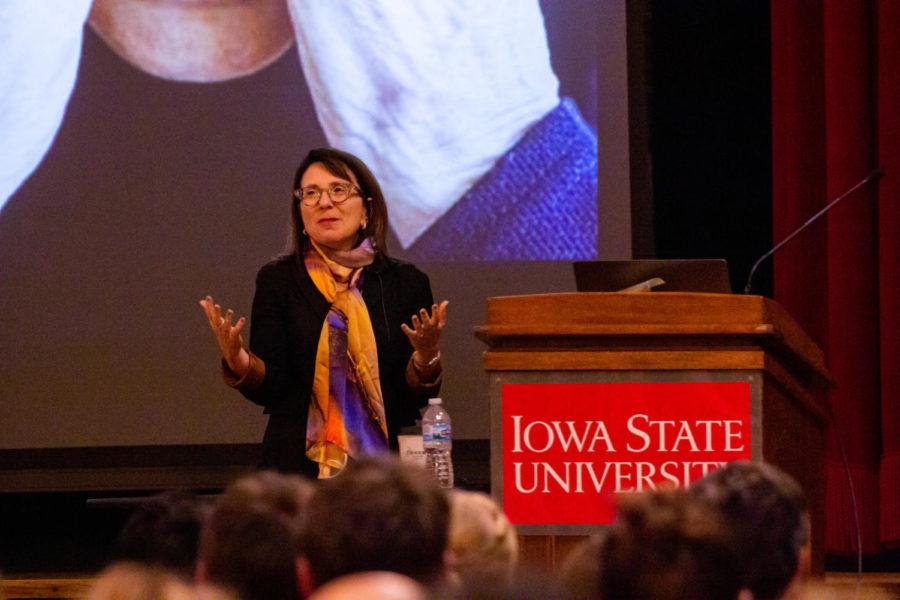Barrett separates emotion facts from fiction in research lecture
GARRETT HEYD / IOWA STATE DAILY
Keynote speaker Lisa Feldman Barrett presented her research Tuesday for 2019 Neuroscience Research Day.
September 10, 2019
Lisa Feldman Barrett attempted to separate fact from fiction about emotions and the brain Tuesday during her speech in the Great Hall of the Memorial Union. Barrett, a distinguished professor of psychology at Northeastern University, was the Neuroscience Research Day 2019 keynote speaker.
Barrett is the author of “How Emotions are Made: The Secret Life of the Brain,” which was released in 2017. The book shares with readers how emotions are constructed by the moment and sheds new light on the meaning of human emotions.
During her lecture, Barrett discussed her research and paradigm-shifting theory. This theory says feelings like happiness, pride and rage are not hardwired and triggered, but are instead constructed in the moment based on experience and learned behavior.
Throughout her lecture Barrett presented three fictions: emotions are displayed on the face with expressions that we recognize, each emotion has a unique pattern of physical changes in the body and each emotion has its own dedicated neurons in the brain.
Barrett began the speech by sharing the facial expressions we all recognize. Her primary example was a scowl, which is mostly associated with anger.
Barrett shared that approximately 20 percent of the time people actually scowl when they’re angry.
“People scowl many times when they aren’t even angry,” Barrett said. “When you show people photographs, and ask them to identify the emotions, they generally all agree with each other. But the discrepancy is we assume people scowl from anger, but they may be scowling from something else.”
According to Barrett and her colleagues’ findings in their studies, people’s faces and emotions vary, based on one another.
“When it comes to facial expressions and emotion, variation is the norm,” Barrett said. “Guesses of emotion occur automatically. The way our brains are wired is that we guess; we guess efficiently and we guess automatically.”
Barrett said this explains why a single feature like a smile can take on different meanings in different emotions.
“Facial expressions are essentially stereotypes,” Barrett said.
Barrett said that physical changes in the body have no emotional meaning and the brain makes bodily changes meaningful as an emotion.
“Your brain’s job is to basically budget all your internal resources to keep you alive and well,” Barrett said. “Emotions in a sense are what your bodily sensations mean in a given situation.”
Barrett’s work has made an impact in the fields of neuroscience, psychology, medicine, the legal system, child-rearing and airport security. According to her website, Barrett currently conducts research at Harvard Medical School and Massachusetts General Hospital.
Some of Barrett’s other accomplishments include testifying in front of Congress, presenting her research to the FBI, being elected a fellow of the American Academy of Arts and Science and receiving the National Institutes of Health Director’s Pioneer Award. Barrett has also been on several different talk shows to discuss her research focused on neuroscience and emotions.
“Emotions are complex constructions; they are not simple circuits,” Barrett said. “Your brain does not have an emotional control panel operated by cute little characters.”
Barrett said one of the most cherished narratives within western culture is the brain is a battleground between reason and emotion, although Barrett emphasized this theory is wrong.
“Emotions are not built into your brain; they are built by your brain as you need them,” Barrett said. “Emotions do not happen to you; they are made by you. Your brain is making them by using information from the world and your body.”
Barrett ended her lecture by sharing examples of how the brain works and interacting with the crowd.
She closed with the statement, “emotions that seem to happen to you, are actually made by you.”







